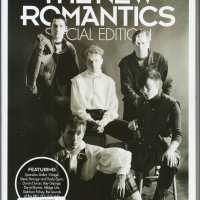
July 7, 2015

The Human League entered 1981 with a handicap. Manager Bob Last had engineered a split between the actual musical portions of the group [who went on to form the British Electric Foundation and Heaven 17] and its singer and visual artist [Phil Oakey and Philip Adrian Wright]. Virgin and Last had enough faith in them to issue a single in the early weeks of 1981 that was made under the aegis of Richard Manwaring, who had produced their earlier music. To these ears, it sounded not terribly different from the material on the first two Human League albums. Stark electronic pop with darkly foreboding lyrics about… I’m not sure what, actually.
Tellingly, the song’s B-side was a full on geek-fest with the instrumental track “Tom Baker.” Philip Adrian Wright made slides for the band’s shows and curated the A/V aspect of their stage presence. He was their visual designer who was obsessed with Doctor Who… is there anything more geeky than that? The B-side was a very fair pastiche/homage to the BBC Radiophonic Workshop sounds that could be heard on the soundtrack to the infinitely long running sci-fi program. It would be the last time that their roots were showing in public quite so boldly. It failed to trouble the charts.
Everything changed for the band when the decision was made to work with noted producer Martin Rushent. He had come up the studio system and had quite a number of successful jobs on his CV by 1981. He was particularly known for a run of fine singles/albums by The Stranglers and The Buzzcocks in the early phases of their careers. For reasons we’ll see later, he crucially produced last single by The Rezillos [“Destination Venus”] before their breakup and re-emergence as The Revillos. All of this was guitar based New Wave, more or less. But by 1980, he had fallen in with the Blitz house band, Visage, and he had given them a boost by giving them studio space and helping them to issue their 1979 debut 7″ “Tar.” He was struck by the new electronic toys that the band and Midge Ure had brought with them to play with.
The next year, he found himself working with Jo Callis’ new band he was in after leaving The Rezillos. Both bands were managed by Bob Last and Bob thought that Jo’s songwriting might be handy in a group now consisting of a singer and visual artist. Callis became an important contributor to The Human League Mk II that issued their follow up single to the d.o.a. “Boys + Girls” single just two months later. The difference in the records was noticeable. Much of the sonic palette was similar, but the track was a much poppier dance track. Almost funky, albeit stiffly so. It had a hard beat but featured a much more comprehensible lyric that at least had a chorus one could sing along to about the inclusionary aspects of youth cults… or some such. The verses were more typical of The League in that I’m not sure exactly what they are about. But the difference was enough to give the band their first top 20 chart hit in the year that everyone was ready for them, finally.
What happened next was nothing less than a blueprint for all modern pop music production. After producing that single, Rushent latched onto the recently released Linn Drum computer and rhythm tracks, up until now, the bane of The Human League’s existence, were summarily conquered while still [technically] hewing to their “synthesizers and voices only” manifesto, which would soon get tossed out of the window, for what’s it’s worth. Thusly armed with this drum machine full of digital percussion samples and his trusty Roland Microcomposer MC-4, Mr. Rushent could now construct the band’s music programmatically. The Linn kept the beat and the MC-4, which was designed by Roland as a composing tool, sequenced all of the spidery synth lines that came together to make the mega-selling “Dare” album.
The sound was fresh at the time and all of the three remaining singles from the album were hits, with “Don’t You Want Me” becoming their signature tune. It was the fourth single from the album, yet a month-long Christmas #1 smash in the UK and, six months later, number one in America for three weeks in a row. This single, more than anything, was the harbinger of things to come for synthpop. The transformation of The Human League from cult electronic weirdos [barely] slumming in pop to Smash Hits heroes on walls everywhere for a few years, had everything to do with the excising of their underground element [Ware and Marsh] by their manager, and the subsequent surrounding of singer Oakey with experienced musicians like Ian Burden and especially Jo Callis. With Rushent in the producer’s chair, the left-field technopop beast was by now yoked and domesticated down to the more commercially acceptable synthpop variety. With that, The Human League had the rare distinction of being both an example of Generation A and the leading edge of Generation B of the emergent synthpop genre. At the end of 1981, they were set to rule the roost but they had some younger, hungrier competition.
Next: …Generation B Strikes Back!











![Rock GPA: Orchestral Manoeuvres In The Dark [part 77]](https://postpunkmonk.files.wordpress.com/2023/12/omd-2023-black-red-andy-paul.jpg?w=200&h=200&crop=1)
![Forty Years Ago Today, Simple Minds Changed Everything with "New Gold Dream [81,82,83,84]"](https://postpunkmonk.files.wordpress.com/2022/09/new-gold-dream-in-spotlights.jpg?w=200&h=200&crop=1)
![Nits Enthrall For Their Golden Jubilee Concert At Royal Theatre Carré [part 2]](https://postpunkmonk.files.wordpress.com/2024/04/nits50-stage-2.jpg?w=200&h=200&crop=1)
Loving these articles PPM. A favourite genre of mine, but I’m learning a lot. Looking forward to the next installment.
LikeLiked by 1 person